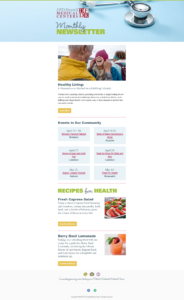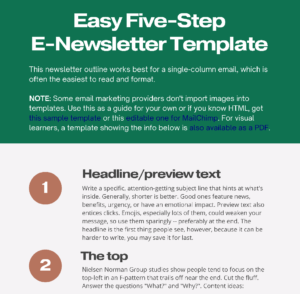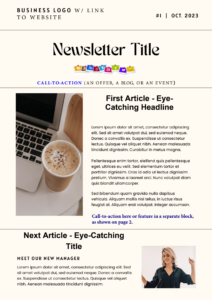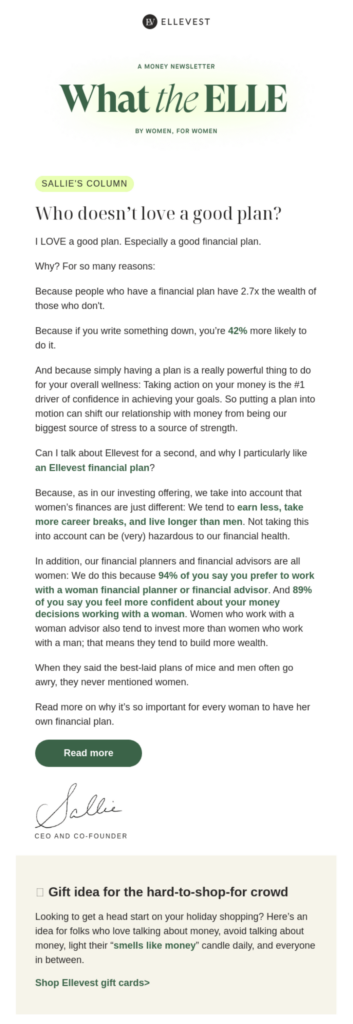What Are The Best Health and Wellness Newsletters?
The best health and wellness newsletters feature accurate and informative content from credible sources. A trustworthy, well-written health e-newsletter requires attention to detail. It avoids unfounded claims, separates facts from opinions, and shows information sources clearly.
As a health writer, I turn technical terms into easy-to-read language. If you struggle to create a newsletter everyone can understand, consider my e-newsletter packages or get a free audit.
What Are The Best Health and Wellness Newsletters?
The top health newsletters for consumers are trustworthy and informative. The World Health Organization (WHO) and Harvard Health Publishing create some of the most acclaimed emails. Among the best free healthcare newsletters, many lesser-known options are equally noteworthy.
Let’s explore some providers’ emails, including their focuses, audiences, and unique value propositions.
What Are Some Health Newsletter Examples?
DFD Russell Medical Centers Newsletter
- Focus area: healthy living and maintaining good health
- Target market: Middle-aged and older adults
- Unique value proposition: practical tips for healthy living (implied from the content and the bottom tagline)

Each e-newsletter features a simple format and clear content on disease prevention.
The advice is based on well-known medical expertise and principles. Possibly to appeal to short attention spans, it lacks depth, and much of it is generic.
Trustworthy content establishes credibility. DFD could quote experienced staff members and link back to data sources to add credibility. They try to convey it through showing awards from The Health Resources and Services Administration.
The single-column format features graphics, distinct headlines, and white space for breathing room. Their appealing logo could be smaller. The pastel color scheme adds a sense of lightness throughout.
To improve accessibility, a few elements could be added or enhanced:
- “alt-text” could be added to the image descriptions.
- colors that contrast better could fill the call-to-action buttons.
- the text size could be larger and in a sans-serif font.
- the recipe image header could be removed in favor of a text heading.
To comply with CAN-SPAM laws, the main physical location of the center could be added to the footer. Other improvements include more persuasive CTA text and adding social media/website icons to the top to boost clicks.
This attractive e-newsletter promotes healthy living effectively. As light reading, it likely engages its audience.

SESAME
- Focus area: healthcare screenings and events
- Target market: patients looking for low-cost same-day care with certified providers
- Unique value proposition: Affordable, quality care
This short email stays on brand throughout, highlighting SESAME’s affordable care options. It features a blog, seasonal topics, and links to related care. The clear call-to-action promotes low-cost doctor visits: “pay half, be whole.”
The design scheme uses only a few colors. Few newsletters place calls to action at the top. SESAME provides an effective example. To maximize where readers tend to look, they could move it more toward the top left.
There are a few opportunities to boost engagement. For instance, the final CTA text could be clearer and more interesting, suggesting readers discover how to save.
To build trust and credibility, the content could feature less style and more substance, through providers’ advice or patient success stories. This content can sometimes sell as well, and work alongside persuasive copy. Placing a second social media icon bar could entice more clicks.
The e-blast effectively promotes SESAME’s unique value proposition of low-cost access to healthcare.
What Are Some Health and Wellness Newsletter Ideas?
The newsletters above offer good examples of potential topics. Some health newsletter topics for certain niches that are adaptable to related sectors:
Nutrition
- 9 Signs of Common Nutrient Deficiencies
- What Are The 7 Types of Nutrition?
- How to Eat a Balanced Diet
Mental Health
- 7 Quick Ways to Calm Anxiety
- 9 Mental Health Myths Debunked
- How to Talk to a Child About an Addiction
Preventive Care
- Are Your Health Screenings Current?
- Preventive Care: What’s Free and What’s Not
- The Differences Between Wellness and Preventive Care
Possible regular columns for these topics:
- Q&A with experts
- upcoming health classes
- healthful recipes
Informative content is crucial for effective health and wellness newsletters that enhance readers’ knowledge and decision-making. Research has found newsletters can influence readers’ health knowledge, attitudes, and motivation, and affect changes in their behavior.
“Exclusive offers through discounts or packages on health care services such as professional consultations should be highlighted or introduce new services so that customers will become curious enough to explore them further.”
keran smith, co-founder and cmo, lyfe marketing
Writing a Health and Wellness Newsletter
Engaging healthcare newsletters balance well-researched, HIPAA-compliant content with a reader-friendly format and tone. They also use credible information and follow privacy guidelines.
To prevent potential claims, add a disclaimer stating the information isn’t medical advice. Also, avoid false advertising claims and when using secondary sources, respect intellectual property rights.
Misinformation, bias, and unsubstantiated claims abound online. Verify the accuracy and objectivity of information sources. Reliable sources include government websites like the Centers for Disease Control and Prevention, National Institutes of Health, and MedlinePlus.
When citing data, use the most up-to-date and authoritative primary sources like peer-reviewed journal articles and data from reputable organizations. Include complete citation details like authors, titles, publication dates, and website links. Quote or summarize the information precisely to give credit and maintain reliability.
Knowing how to write a newsletter article can prepare you for writing a business newsletter or how to create a professional email newsletter.
The Best Health and Wellness Newsletters Feature Engaging Content
Professionals’ and patients’ experiences enhance the best health and wellness newsletters. This unique advice also builds trust and credibility and helps them stand out.
If crafting an engaging health newsletter takes too much time, consider my e-newsletter packages or get a free audit.





